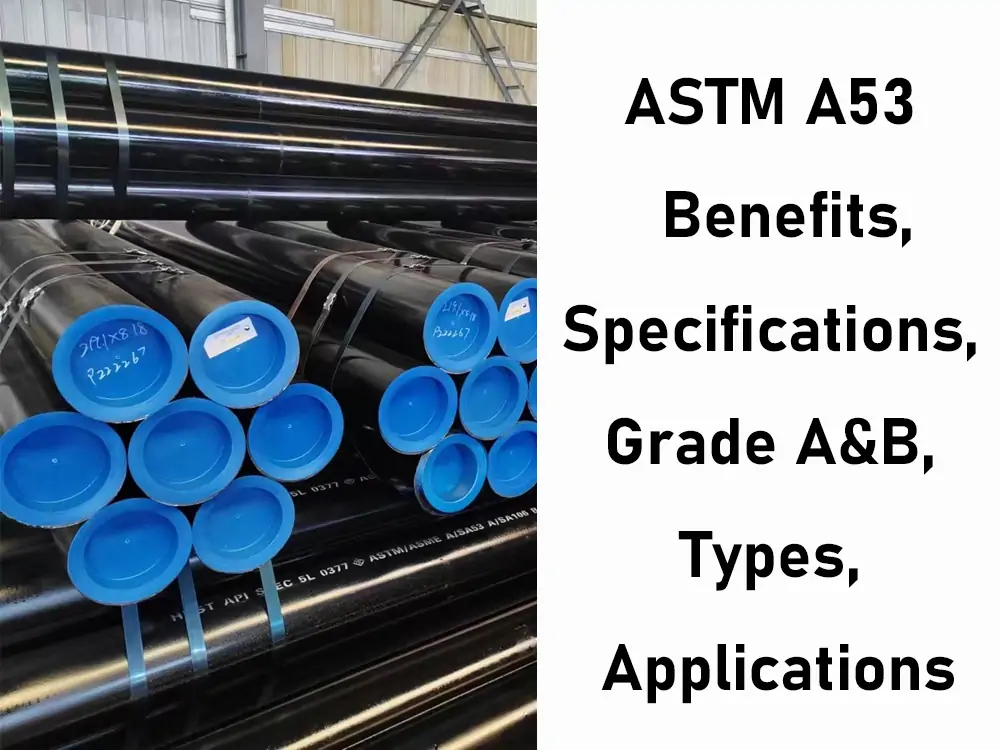소개
ASTM A53 는 미국 재료 시험 협회(ASTM)에서 개발한 강관 규격입니다. 이 표준은 배관, 난방, 가스 및 기타 중요한 애플리케이션에 사용되는 파이프의 재료 특성을 정의합니다. 다용도성과 강도로 인해 ASTM A53 파이프는 는 건설, 제조 및 산업 프로젝트에서 널리 사용됩니다. 이 표준에는 용접, 이음매 없는, 아연 도금 파이프와 같은 다양한 등급(등급 A 및 등급 B), 유형 및 형식이 포함되며, 각각 다른 용도로 사용됩니다.
A53 사양은 세 가지 주요 유형의 파이프로 나뉩니다:
타입 F, 타입 E, 타입 S의 세 가지 유형은 각각 제조 공정 및 기계적 특성과 관련하여 특정 특성을 가지고 있습니다. 이러한 파이프는 일반적으로 시스템에서 고압 및 고강도 파이프가 필요한 곳에 사용됩니다.
이 문서에서는 다음과 같은 여러 측면을 살펴봅니다. ASTM A53 파이프의 장점과 등급, 다양한 종류, 용도, 다른 강종과의 차이점 등 다양한 정보를 확인할 수 있습니다.
A53 스틸의 장점
압력 테스트 완료
비판적 평가 ASTM A53 강철은 압력 용량 측면에서도 유용한 특성을 가지고 있습니다. 파이프는 제조 및 테스트 과정에서 사용하려는 특정 압력에 도달하도록 압력을 가하기 때문에 압력 관련 물, 오일 및 가스 시스템에 사용하기에 이상적입니다.
부식 방지
ASTM A53 파이프 는 부식에 강하며, 특히 아연 도금된 경우 더욱 그렇습니다. 이러한 내식성은 습기, 화학 물질 및 기타 부식성 물질에 의해 파이프가 부식되기 쉬운 실외 및 해양 지역에서 특히 유용합니다.
진동 및 충격 방지
ASTM A53 파이프 는 진동과 충격을 견딜 수 있도록 설계되어 건설, 운송 및 에너지 플랜트 산업에서 널리 사용됩니다. 이 소재는 충격과 진동에 강해 장기적으로 이러한 혹독한 환경을 견딜 수 있습니다.
높은 강도
이렇게 하면 ASTM A53 파이프 인장 강도가 높기 때문에 압력과 무게를 견딜 수 있습니다. 따라서 수도 및 가스 공급, 구조물, 공조 시스템에서 가정용 및 상업용으로 사용하기에 적합합니다.
비용 효율적
기계적 특성으로 인해 가장 경쟁력 있는 강관 중 하나이며 다음과 같은 다른 강관에 비해 가격이 상당히 저렴합니다. ASTM A53. 파이프는 매우 저렴하므로 저렴하지만 좋은 품질의 파이프가 필요한 대규모 프로젝트에 사용할 수 있습니다.
A등급 대 B등급
ASTM A53 강철 파이프는 크게 두 가지 등급으로 나뉩니다: 등급마다 기계적 특징이 다르고 합금의 함량도 다릅니다.
화학 성분
저탄소 소재인 탄소강은 주로 적당한 강도를 제공하는 A등급 파이프를 만드는 데 사용됩니다. 반대로 B등급 파이프는 탄소 함량이 약간 높기 때문에 인장 강도가 높아 더 높은 압력에 적합합니다.
- A등급: 탄소 함량 최대 0.26%
- B등급: 탄소 함량 최대 0.30%
관찰된 탄소 비율의 차이로 인해 B등급 파이프는 A등급 파이프에 비해 기계적 특성이 향상되고 이러한 응력 하중을 견딜 수 있습니다.
기계적 특성
- A등급: 가장 강도가 낮은 이 파이프는 대량의 파이프 어레이에서 중요하지 않은 저압 시스템에만 적합합니다.
- B등급: B등급 파이프는 A등급 파이프보다 강도와 압력 수용 능력이 높기 때문에 산업용에 더 적합합니다.
코팅 대 용접 및 아연 도금 형식
코팅, 용접 및 아연 도금 유형 주목할만한 점은 다음과 같습니다. ASTM A53 파이프는 여러 가지 형태로 찾을 수 있습니다: 단조, 코팅, 용접, 심지어 아연 도금까지. 사용 중인 형식에 따라 두 가지 모두 일반적인 애플리케이션과 관련하여 고유한 개선 사항을 제공합니다.
코팅 파이프
코팅된 파이프는 부식과 마모로부터 더 잘 보호하기 위해 파이프 외부에 추가 층을 적용합니다. 이러한 코팅은 에폭시, 폴리우레탄 또는 시멘트 등 다양한 형태로 제공되어 구조물의 표면 코팅을 강화합니다. 이러한 코팅은 특히 습기나 화학 물질에 노출되는 파이프의 수명을 늘리기 위해 적용됩니다.
용접 및 아연 도금 파이프
용접 ASTM A53 파이프 강철 코일/플레이트를 결합하여 만들어집니다. 큰 직경에 사용되며 이음매 없는 파이프보다 저렴합니다. 아연 도금: 녹이 슬지 않도록 아연으로 코팅된 파이프로, 습도가 높거나 화학 물질의 영향을 많이 받는 지역에서 사용할 수 있습니다.
ASTM A53 파이프의 종류
ASTM A53 유형 F
F형 파이프는 가열을 통해 파이프 끝을 접합하는 용광로 맞대기 용접 방식으로 제조된 파이프로 제작됩니다. 강도가 적당하며 급수관과 같은 일반적인 용도로 구매합니다.
ASTM A53 유형 E
E형 파이프는 전기 저항 용접 파이프로, 강철을 전기 저항으로 접합합니다. 일반적으로 F타입 파이프보다 더 견고하며 적당한 압력이 필요한 곳에서 잘 사용됩니다.
ASTM A53 유형 S
S타입 파이프는 용접 작업을 통해 제작되지 않고 이음매가 없습니다. 세 가지 유형 중 가장 견고하므로 고압 파이프 시스템을 필요로 하는 중요한 애플리케이션에 이상적입니다.
다른 강종과의 비교 이 부품에 적합한 강종 이 부품에 적합한 강종 이 부품에 적합한 강종 금속 블랭크 이 부품에 적합한 강종 금속 블랭크 이 부품에 적합한 강종 스트립강 이 부품에 적합한 강종 스트립강
다른 강종과의 비교
A53 대 A500
ASTM A53 는 범용 파이프용이며, ASTM A500은 구조용입니다. A500 파이프는 인장 강도가 향상되었으며 주로 건축 및 골조 작업에 적용됩니다. 따라서 ASTM A53 파이프 는 저압을 사용하는 시스템에 사용되며 파이프의 기계적 특성에 대한 엄격한 요구 사항이 없는 반면, A500은 특히 하중을 견디는 응용 분야에서 강도를 위해 사용됩니다.
A53 파이프의 치수
ASTM A53 파이프 표준 파이프 크기는 직경 ½(1/8″)에서 26(인치)까지 다양한 크기로 제조됩니다. 다양한 두께로 제공되며, 명시된 외경과 벽 두께는 파이프 스케줄에 따라 다릅니다. 가장 많이 사용되는 스케줄에는 스케줄 40, 스케줄 80 및 스케줄 160이 있습니다.
이러한 파이프는 모든 파이프의 균일성과 표준을 보장하기 위해 특정 크기와 무게 요건에 맞게 제조됩니다. 따라서 파이프의 직경은 압력 등급과 파이프가 서비스할 시스템에 대한 유체 순환 용량에 따라 결정됩니다.
A53 스틸의 응용 분야
ASTM A53 강철 파이프는 높은 내구성과 강도로 대부분의 산업에서 사용됩니다. 주요 응용 분야는 다음과 같습니다:
- 수도 및 가스 파이프라인: ASTM A53 파이프는 다양한 지자체 및 산업 분야의 수도 및 가스 전송 시스템에 사용됩니다.
- 구조적 프레임워크: 강도와 유연성이 높기 때문입니다, ASTM A53 파이프는 철골 구조물, 건물, 교량을 건설하는 데 사용할 수 있습니다.
- HVAC 시스템: A53 파이프는 가구, 난방, 냉방 및 환기 시스템에서 공기, 물 또는 냉매를 운반합니다.
- 석유 및 화학 물질 운송: ASTM A53 파이프는 적절한 강도와 내식성을 갖추고 있어 석유, 가스 및 화학 물질의 운송이 불가피한 산업에서 사용하기에 이상적입니다.
- 해양 및 실외 애플리케이션: 아연 도금 ASTM A53 파이프의 특징은 다음과 같습니다. 해양 애플리케이션 및 극한 기후 지역에서 관리할 수 있는 기타 건축물을 포함한 광범위한 애플리케이션에 사용할 수 있습니다.
결론
기능, 다양한 사용법, 건설적인 기능, 합리적인 가격으로 인해, ASTM A53 파이프 다양한 분야의 많은 기업에서 중요한 역할을 담당하고 있습니다.
이러한 품질, 부식 방지 기능, 내압성 및 높은 강도로 인해 배관, 건설 작업 등에 가장 적합합니다. 다양한 등급과 파이프 유형을 포함한 A53의 특성을 인식하고 비교하여 사용자로서 작업에 적합한 파이프를 선택하는 것이 중요합니다.
수도 시스템 구조, 구조물 및 금속 배관이 필요한 기타 시스템과 관련된 문제, ASTM A53 작업을 안전하고 지속적으로 유지합니다.
어떤 파이프를 사용할지 결정하기 전에 몇 가지 요소를 고려하여 다음 사항을 결정해야 합니다. ASTM A53용도, 환경, 압력 등급 및 기계적 특성에 따라 A등급 또는 B등급이 더 적합할 수 있습니다.

